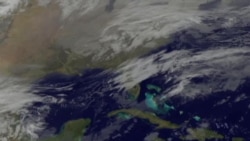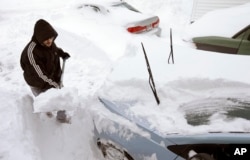The northeastern United States is cleaning up after a powerful snowstorm that hit the region this week, forcing airports, schools and businesses to close. It also left people wondering whether the event was linked to climate change.
2014 was the warmest year on modern record, according to the National Oceanic and Atmospheric Administration and the National Aeronautics and Space Administration, working independently.
Snowstorm, isolated weather event
Wayne Higgins watched the storm from a monitor at NOAA, where he heads the agency’s climate program. He explains what caused the storm: increased moisture in the air, fed by a band of southerly winds that picked up water vapor from the warm Gulf Stream. This clashed with cooler Arctic air common this time of year. It was an isolated weather event, Higgins says.
“You cannot link an individual extreme event such as a northeaster snow event, such as a cold air outbreak, such as a severe weather outbreak to global warming,” he said.
Yet regional snowstorms in the United States are on the rise, according to a 2013 consensus report published in the Bulletin of the American Meteorological Society. It states, “The number of regional snowstorms since 1960 is twice the number that occurred during the preceding 60 years.”
There’s just not enough data to make the connection with global warming for the recent storm that blanketed the northeast, Higgins says. If you want to see the effect of global climate change, he explains, you look for patterns: historic records and projections that detail the number, frequency and intensity of extreme events that relate to temperature.
“So where we’ve looked forward decades, even out to a century and using those climate models with scenarios in which we actually ramp up the levels of greenhouse gases, we are able to confirm that human-induced climate change is something that is occurring now and that is actually likely to continue in the future,” he said.
More droughts, heavy downpours, heat waves
Higgins says scientists are beginning to relate those global patterns to extreme weather events, like heat waves in Europe, heavy rainfall in Asia and drought that is gripping Australia, Africa and California, which is suffering its most severe drought in a quarter century. Higgins says the impact is staggering.
"For example, the ability to sustain water levels in the reservoirs is not there, and so of course drinking water for people is an issue," he said. "And, as we go forward in time - if we continue to project that there will be continuing or increasing numbers of droughts in that region - you can see that we have quite a risk to the water supply.”
The global warming trend is tied to the rise in carbon dioxide from the coal we burn, the electricity we use and the cars we drive. Those gases are warming the planet. Higgins says the extremes we see today are a sign that more frequent and more intense rainfall, drought, and heat waves are on the way.
New normal
“The point here is that these events are causing up to billions of dollars of damage," he pointed out. "As we see the increasing trends in these metrological and hydrological extremes, as a society we really need to think about how we are going to manage the risk, how we’re going to adapt to these changes in extremes.”
Higgins says global warming is happening now. The extremes describe a new normal, where resources for life - the water we drink and the food we eat - are at stake.











